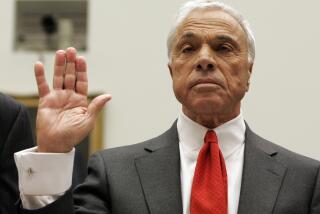Keynes can’t help us now
- Share via
It began as a subprime surprise, became a credit crunch and then a global financial crisis. At last week’s World Economic Forum in Davos, Switzerland, Russia and China blamed America, everyone blamed the bankers, and the bankers blamed you and me. From where I sat, the majority of the attendees were stuck in the Great Repression: deeply anxious but fundamentally in denial about the nature and magnitude of the problem.
Some foretold the bottom of the recession by the middle of this year. Others claimed that India and China would be the engines of recovery. But mostly the wise and powerful had decided to trust that John Maynard Keynes would save us all.
I heard almost no criticism of the $819-billion stimulus package making its way through Congress. The general assumption seemed to be that practically any kind of government expenditure would be beneficial -- and the bigger the resulting deficit the better.
There is something desperate about the way economists are clinging to their dogeared copies of Keynes’ “General Theory.” Uneasily aware that their discipline almost entirely failed to anticipate the current crisis, they seem to be regressing to macroeconomic childhood, clutching the Keynesian “multiplier effect” -- which holds that a dollar spent by the government begets more than a dollar’s worth of additional economic output -- like an old teddy bear.
They need to grow up and face the harsh reality: The Western world is suffering a crisis of excessive indebtedness. Governments, corporations and households are groaning under unprecedented debt burdens. Average household debt has reached 141% of disposable income in the United States and 177% in Britain. Worst of all are the banks. Some of the best-known names in American and European finance have liabilities 40, 60 or even 100 times the amount of their capital.
The delusion that a crisis of excess debt can be solved by creating more debt is at the heart of the Great Repression. Yet that is precisely what most governments propose to do.
The United States could end up running a deficit of more than 10% of GDP this year (adding the cost of the stimulus package to the Congressional Budget Office’s optimistic 8.3% forecast). Nor is that all. Last year, the Bush administration committed $7.8 trillion to bailout schemes, in the form of loans, investments and guarantees.
Now the talk is of a new “bad bank” to buy the toxic assets that the Troubled Asset Relief Program couldn’t cure. No one seems to have noticed that there already is a “bad bank.” It is called the Federal Reserve System, and its balance sheet has grown from just over $900 billion to more than $2 trillion since this crisis began, partly as a result of purchases of undisclosed assets from banks.
Just how much more toxic waste is out there? New York University economist Nouriel Roubini puts U.S. banks’ projected losses from bad loans and securities at $1.8 trillion. Even if that estimate is 40% too high, the banks’ capital will still be wiped out. And all this is before any account is taken of the unfunded liabilities of the Medicare and Social Security systems. With the economy contracting at a fast clip, we are on the eve of a public-debt explosion. And similar measures are being taken around the world.
The born-again Keynesians seem to have forgotten that their prescription stood the best chance of working in a more or less closed economy. But this is a globalized world, where uncoordinated profligacy by national governments is more likely to generate bond-market and currency-market volatility than a return to growth.
There is a better way to go: in the opposite direction. The aim must be not to increase debt but to reduce it.
This used to happen in one of two ways. If, say, Argentina had an excessively large domestic debt, denominated in Argentine currency, it could be inflated away -- Argentina just printed more money. If it were an external debt, the government defaulted and forced the creditors to accept less.
Today, America is Argentina. Europe is Argentina. Former investment banks and ordinary households are Argentina. But it will not be so easy for us to inflate away our debts. The deflationary pressures unleashed by the financial crisis are too strong -- consumer prices in the U.S. have been falling for three consecutive months. Nor is default quite the same for banks and households as it is for governments. Understandably, monetary authorities are anxious to avoid mass bankruptcies of banks and households, not least because of the downward spiral caused by distress sales.
So what can we do? First, banks that are de facto insolvent need to be restructured, not nationalized.(The last thing the U.S. needs is to have all of its banks run like Amtrak or, worse, the IRS.) Bank shareholders will have to face that they have lost their money. Too bad; they should have kept a more vigilant eye on the people running their banks. Government will take control in return for a substantial recapitalization, but only after losses have been meaningfully written down. Those who hold the banks’ debt, the bondholders, may have to accept a debt-for-equity swap or a 20% “haircut” -- a disappointment, but nothing compared with the losses suffered when Lehman Bros. went under.
State life-support for dinosaur banks should not and must not impede the formation of new banks by the private sector. It is vital that state control does not give the old, moribund banks an unfair advantage. So recapitalization must be a once-only event, with no enduring government guarantees or subsidies. And there should be a clear timetable for “re-privatization” -- within, say, 10 years.
The second step we must take is a generalized conversion of American mortgages to lower interest rates and longer maturities. About 2.3 million U.S. households face foreclosure. That number is certain to rise as more adjustable-rate mortgages reset, driving perhaps 8 million more households into foreclosure and causing home prices to drop further. Few of those affected have any realistic prospect of refinancing at more affordable rates. So, once again, what is needed is state intervention.
Purists say this would violate the sanctity of the contract. But there are times when the public interest requires us to honor the rule of law in the breach. Repeatedly in the course of the 19th century, governments changed the terms of bonds that they issued through a process known as “conversion.” A bond with a 5% return was simply exchanged for one with a 3% return, to take account of falling market rates and prices. Such procedures were seldom stigmatized as default.
Another objection to such a procedure is that it would reward the imprudent. But moral hazard only really matters if bad behavior is likely to be repeated, and risky adjustable-rate mortgages aren’t coming back soon.
The issue, then, becomes one of fairness: Why help the imprudent when the prudent are struggling too?
One solution would be for the government-controlled mortgage lenders and guarantors, Fannie Mae and Freddie Mac, to offer all borrowers -- including those with fixed rates -- the same deal. Permanently lower monthly payments for a majority of U.S. households almost certainly would do more to stimulate consumer confidence than all the provisions of the stimulus package, including tax cuts.
No doubt those who lost by such measures would not suffer in silence. But the benefits would surely outweigh the costs to bank shareholders, bank bondholders and the owners of mortgage-backed securities.
Americans, Winston Churchill once remarked, will always do the right thing -- after they have exhausted all other alternatives. If we are still waiting for Keynes to save us when Davos comes around next year, it may well be too late. Only a Great Restructuring can end the Great Repression. It needs to happen soon.
More to Read
Inside the business of entertainment
The Wide Shot brings you news, analysis and insights on everything from streaming wars to production — and what it all means for the future.
You may occasionally receive promotional content from the Los Angeles Times.










